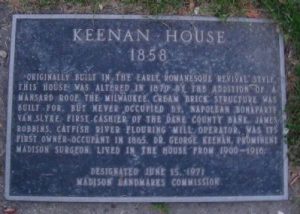George Keenan House

Before you ask, let me say it: the mansard roof is a later addition of 1870. The house was originally built as an Italianate and seems to have an intact Italianate façade; the roof was simply altered to keep up with the Second Empire fashion.
When looking at it, you just have to imagine the low hip roof that originally would have crowned it. There might also have been a cupola akin to the Pierce house. The reason I decided to post this house, which is a block from the Pierce house, is that it also manifests the marriage of Italianate and Rundbogenstil.
The house was built in 1858 for Napoleon Van Slyke (there’s a name!) who never lived in it. It is named after a famous surgeon who lived here in the early 20th century. The designer was August Kutzbock, the architect responsible for Madison’s collection of Rundbogenstil designs. Unlike the wooden John Hill house and the sandstone Pierce house, this house is constructed of Milwaukee cream brick, a specialty of Wisconsin, and follows the symmetrical plan.
In fact, aside from the sandstone highlights, the entire house, even the decorative balconies and cornice, is constructed of brick. The projection of the central front bay is common to this type, as we have seen. It might have originally had a gable above it.
The paired tombstone windows are by now a familiar feature of Italianate design as is the grouping of the first floor windows by a common cornice. It somewhat resembles the window treatment of the Reddick house. Another telltale Italianate feature is the wooden awning that crowns the small door on the façade of the ell to the right of the house.
The house manifests Rundbogenstil in its cornice and impressive porches. The brick cornice is supported by a series of brick brackets that resemble the corbels and machicolations of Medieval castle architecture. This is set over a simple fringe of inverted crenellations that almost resemble dentils. The cornice switches to a simple dentilled design on the projecting section, which might be a later addition.

The windows in classic Rundbogenstil manner are rounded, feature a Gothicized Venetian tracery, and are surrounded by sandstone hood moldings and capitals featuring inverted crenellations. The first floor windows have a similar treatment are on a slight projection crowned by a cornice. The central bay has bricks laid in a blind flat topped trefoil arch and a traditionally traceried window. The house has two impressive Romanesque porches. Each features sandstone turrets at the corners, setting off an undulating brick balustrade, an interesting design. The brick is laid so that projections resemble an odd abstraction of inverted crenellations. While the Pierce house seems to draw inspiration from Romanesque church architecture, the Keenan house definitely has a castle-like feeling, demonstrating that the same architect can draw from two very different idioms for the same type of house. Perhaps there was simply a desire to distinguish. The Keenan house, with its mansard that is actually quite well integrated and complementary to Kutzbock’s design, is a unique testimony to Kutzbock’s versatility.




